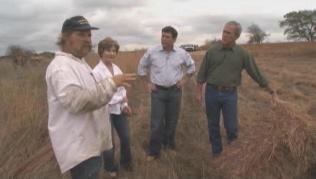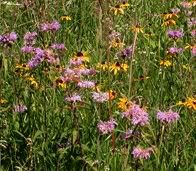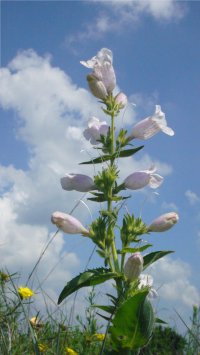 First Lady Laura Bush, President Bush, and Native Prairies Association of Texas (NPAT) member Mike Williams recently toured the tallgrass prairie restoration at the first couple’s Prairie Chapel Ranch with reporter Bret Baier. Mike Williams is the restoration project leader and owner of NPAT-protected Simpson Prairie.
First Lady Laura Bush, President Bush, and Native Prairies Association of Texas (NPAT) member Mike Williams recently toured the tallgrass prairie restoration at the first couple’s Prairie Chapel Ranch with reporter Bret Baier. Mike Williams is the restoration project leader and owner of NPAT-protected Simpson Prairie.
View the video of the tour at the Fox News web site, where the first couple and Mike talk about prairie restoration, Simpson Prairie, and the Native Prairie Association of Texas.
Mike Williams has been using prairie seed collected from Simpson Prairie as the main seed source for the prairie restoration project on Prairie Chapel Ranch, where he is planting native plants such as the native grasses and prairie flowers that thrived on the land before European settlement.
Mike protected Simpson Prairie, a rare and beautiful remnant of Texas tallgrass prairie, for current and future generations via a conservation easement with NPAT. A conservation easement is a voluntary agreement between a landowner and land trust which permanently protects native prairie or other natural features of the property in perpetuity.
Additional seed sources for the prairie restoration project on the Bush Ranch include NPAT members Bob and Mickey Burleson’s native prairie remnant and restoration near Temple, TX.
Laura Bush also wrote an article that appears on the Fox News web site about native prairie restoration and resources available to private landowners.
A field trip to Mike Williams’ Simpson Prairie near Valley Mills will be held on Saturday, May 3rd at 9:30am. We will meet at the bank parking lot on the northwest corner of the main intersection in Crawford and then proceed to Simpson Prairie.
Beautiful and productive tallgrass prairie is the most endangered large ecosystem in North America, and less that 1% of Texas’ tallgrass prairie remains for current and future generations. Native prairie is also habitat for the grassland birds, the most declining group of birds in North America. Conservation and ecological restoration of tallgrass prairie is an important method to protect and increase habitat for the imperiled native plant communities and prairie wildlife like grassland birds.
Native grasslands also protect and improve water quality and sequester carbon in the soil to fight climate change. Tallgrass prairie plantings have been shown to be the best source of cellulosic biofuel while simultaneously sequestering more carbon in the soil than is released by its use as fuel.
You can help protect native prairie by joining the Native Prairies Association of Texas (NPAT). You can also restore native prairie on your own land, and if you own a remnant or restored tallgrass prairie please consider a conservation easement with a land trust like NPAT.
Go to the Fox News website to view the video of Laura and George Bush and Mike Williams and read the prairie restoration article by Laura Bush. View a slideshow of native prairie flowers and grasses on Simpson Prairie at NPAT’s web site.







